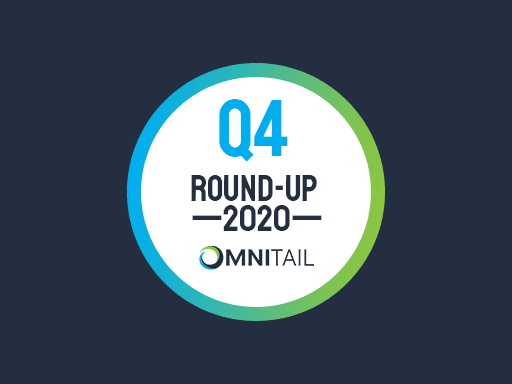As we move into 2021 (finally!), it’s good to take a look back at what changed in Q4 2020—so we can start the year off informed! Here’s a look at some of the biggest e-commerce updates from Q4 2020 and our analysts’ thoughts on the impact of these updates.

1. Google Analytics 4
In October, Google launched the latest version of Google Analytics: Google Analytics 4 (GA4). Unlike previous versions of Google Analytics, the updated reporting is now events-based instead of conversion-based. With this new interface, you can track virtually any event you want – including PDF clicks and form-fills. Learn how to set up Google Analytics 4 for your site.
Marketing Manager’s Thoughts: Christina DiSomma


2. Increasing Video Ads
In Q4, we saw a lot of new video advertising options across different platforms. Amazon released the Sponsored Brand Video beta. These keyword-targeted, CPC ads can appear in search results and on product detail pages.
Google released two video ad updates. First, Google Ads Video Action rolled out in October. These ads appear both on and off YouTube in the skippable in-stream and video discovery ad formats. Second, auto-generated videos for responsive display campaigns also were released in October. Using this new tool, Google will create video ads using your logo, images, and text assets.
Senior SEM Analyst’s Thoughts: CJ Milhoan

“One of the relatively newer options out there is the Amazon Sponsored Brands video. These ads are based on keywords, so if you already have a successful Amazon program, you can leverage search term data/keywords in relation to specific products to decide what items should be featured in your video.
For example, if you know that “Black Crew Cut Socks” or “Chevy Headlights” are keywords/terms that generate decent traffic with proper returns, feature these products in your creative. Amazon is clearly trying to introduce another advertising feature to beef up its current offering.”

3. Google Ads Updates
As Google Ads turned 20 this quarter, they continued to make changes and updates to their platform.
First, Performance Max campaigns, released in October, let retailers set up one campaign to run across all Google Ads inventory including Display Network, YouTube, Discover, and Search. These campaigns are automated and supposed to run alongside standard Search campaigns.
Next, Google Ads has steadily been simplifying location reporting. These changes have made it harder to access some reporting and data, but you can check out this article to learn how to work around those changes.
For Google My Business, Google rolled out a new “Call History” feature which allows businesses to view a missed call log for up to 45 business days.
SEM Analyst’s Thoughts: Sarah French

If the user location matched location is taken out altogether, we are essentially buying a billboard without knowing where it is located. Google has released Video action and Performance Max campaigns to push both YouTube and Discover inventory. The additional ad inventory could be good for advertisers if conversion rates stay steady with the increase.
In my opinion, the best thing Google released in Q4 for e-commerce has been the insights page. As e-commerce trends continue to change quickly, this is a good way to determine if increased conversions are due to consumer behavior.”

4. Facebook Ordered to Break Up
In a groundbreaking lawsuit decision in December, the US government declared that Facebook must be broken up. 48 states sued Facebook for anti-competitive behavior and abuse of power in the digital marketing place. The FTC is seeking to make Facebook separate from Instagram and WhatsApp.
In less major Facebook news – Facebook removed its age-old text restrictions on advertisements and is also dealing with some big reporting glitches.
SEM Strategist’s Thoughts: Elizabeth Kanarek

“To some, it may seem hypocritical that the government officials now want to break up Facebook after they allowed for Facebook’s acquisition of Instagram and WhatsApp. When considering the size and market share of social media that Facebook has attained since these acquisitions, the recent lawsuits become more understandable in the efforts to increase competition in the realm of social media.
It is unclear when or if Facebook will eventually have to break itself up, but if this does come to fruition, it may lead to more complexity in marketing in these channels. Currently, one can create advertisements for WhatsApp, Instagram, and Facebook all through the Facebook ads platform. After these are broken up, marketers will have to separate their ads and management across all the platforms.”

5. Laws and Lawsuits
That’s not the only lawsuit going on. Around the world, big tech companies are under scrutiny for anti-trust violations and breaking privacy laws. Here’s a list of the latest lawsuits and legal action against Google, Amazon, and Social Media platforms in Q4.
- DOJ Accuses Google of Monopoly
- Google Display Anti-Trust Probe Italy
- Amazon charged Anti-Trust Europe
- France Fines Google and Amazon
- California Passes a Major Privacy Law
- FTC Issues Orders to 9 Social Media/video Sites
SEM Strategist’s Thoughts: Chris Kendall


6. 2020 Holiday Season
Every e-commerce business knows this holiday season was a little different – okay a lot different. Prime Day was in October this year, shipping delays had everyone on the edge of their seats, and the fate of Brick-and-Mortar stores seemed to hang in the balance. Now that the holiday season has come to an end, we can look back and reflect on what actually happened.
While Prime Day sales were down from last year, they were up compared to the last 30 days. Ad spend increased 3.8X, ad-driven conversions were up 2.6X, and sales revenue was up 4.9X compared to the previous 30 days according to SearchEngineLand.
Thanksgiving surprisingly went well for e-commerce retailers—with a $5billion increase in sales. After Thanksgiving, companies started hiring—warehousing and transportation added 145,000 new jobs while traditional retail was down 35,000 jobs.
Despite the increase in new hires and couriers, the shipping delay struggle was real. UPS stopped picking up packages from major retailers including Macy’s and Nike during the holiday rush.
During the holidays, mobile shopping was on the rise—as more shoppers made holiday purchases directly from their phones. Adobe cited mobile as 39% of sales, while Shopify cited it as 69% of sales.
Marketing Specialist’s Thoughts: Savannah St. John

Since our analysts watch bids throughout the day on Black Friday and Cyber Monday, they’re able to make quick decisions that keep our clients ahead of their competitors. I think this type of strategy was particularly important in 2020.”








